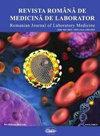Phenotypic Carbapenemase Production and blaOXA detecting by PCR in Acinetobacter baumannii isolates from a Hospital of Infectious Diseases from North-East Romania
IF 0.5
4区 医学
Q4 MEDICINE, RESEARCH & EXPERIMENTAL
引用次数: 0
Abstract
Abstract Introduction: In the last 40 years, Acinetobacter baumannii has been among the bacteria known to acquire multiple mechanisms of antibiotic resistance and, as a result, it is now one of the pathogens involved in healthcare-associated infections with multidrug resistant strains. Our study aimed to assess the production of carbapenemases in carbapenem-resistant A. baumannii by means of phenotypic methods and polymerase chain reaction technique (PCR), as well as to appraise the performances of carbapenemase detection by phenotypic tests compared to the PCR approach. Materials and Methods: We used phenotypic methods (E-test MBL, CIM, MHT, Rosco® Kit/OXA/MBL, OXA-23 K-SeT® assay) to investigate the production of carbapenemases in 43 carbapenem-resistant A. baumannii isolates, and PCR to screen for the genes blaOXA-23, blaOXA-24, blaOXA-58, blaOXA-51, blaVIM, blaIMP and blaNDM. Results: The carbapenem inactivation method (CIM) at 2 hours, CIM at 4h, OXA-23 K-SeT® assay, Rosco® Kit/OXA, and modified Hodge test (MHT) identified 26%, 63%, 65%, 81%, and 42% carbapenemase-producing isolates, respectively. The phenotypic E-test MBL detected metallo-β-lactamase (MBL) production in 79% of strains. PCR revealed blaOXA-51 in all the isolates, blaOXA-23 in 35/43 (81%), blaOXA-24 in 28/43 (65%), blaVIM in 7/43 (3%) and blaOXA-58, blaIMP, blaNDM were not detected. Conclusion: Because phenotypic tests do not highlight all the carbapenemase-producing strains, their results must be interpreted with caution relative to their level of performance, and negative results should be confirmed by means of PCR.罗马尼亚东北部某传染病医院鲍曼不动杆菌分离株碳青霉烯酶表型及blaOXA的PCR检测
摘要简介:在过去的40年里,鲍曼不动杆菌是已知获得多种抗生素耐药机制的细菌之一,因此,它现在是与多药耐药菌株有关的卫生保健相关感染的病原体之一。本研究旨在通过表型方法和聚合酶链反应技术(PCR)评估耐碳青霉烯类鲍曼假单胞菌碳青霉烯酶的产生,并比较表型检测与PCR检测的性能。材料与方法:采用表型方法(E-test MBL、CIM、MHT、Rosco®Kit/OXA/MBL、OXA-23 K-SeT®法)对43株耐碳青霉烯类鲍曼不动杆菌分离株碳青霉烯类酶的产生进行了研究,并采用PCR方法筛选blaOXA-23、blaOXA-24、blaOXA-58、blaOXA-51、blaVIM、blaIMP和blaNDM基因。结果:碳青霉烯酶2小时失活法(CIM)、4小时失活法(CIM)、OXA-23 K-SeT®法、Rosco®Kit/OXA法和改良Hodge法(MHT)分别鉴定出26%、63%、65%、81%和42%的产碳青霉烯酶菌株。表型E-test MBL检测到79%的菌株产生金属β-内酰胺酶(MBL)。PCR检出blaOXA-51, blaOXA-23 35/43 (81%), blaOXA-24 28/43 (65%), blaVIM 7/43 (3%), blaOXA-58、blaIMP、blaNDM均未检出。结论:由于表型试验不能突出所有产碳青霉烯酶的菌株,其结果必须相对于其性能水平谨慎解释,阴性结果应通过PCR手段确认。
本文章由计算机程序翻译,如有差异,请以英文原文为准。
求助全文
约1分钟内获得全文
求助全文
来源期刊

Revista Romana De Medicina De Laborator
MEDICINE, RESEARCH & EXPERIMENTAL-
CiteScore
0.31
自引率
20.00%
发文量
43
审稿时长
>12 weeks
期刊介绍:
The aim of the journal is to publish new information that would lead to a better understanding of biological mechanisms of production of human diseases, their prevention and diagnosis as early as possible and to monitor therapy and the development of the health of patients
 求助内容:
求助内容: 应助结果提醒方式:
应助结果提醒方式:


